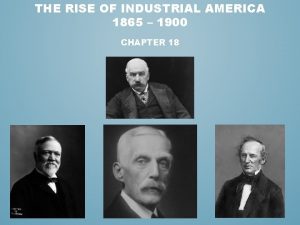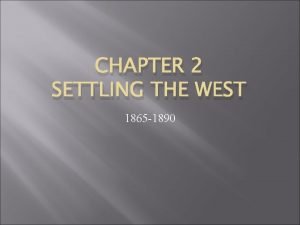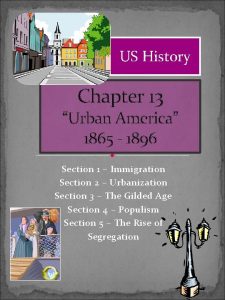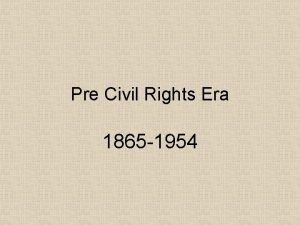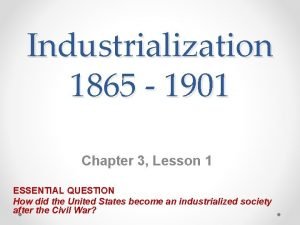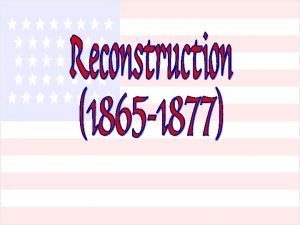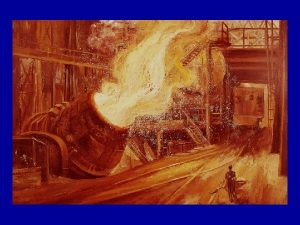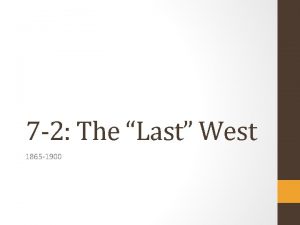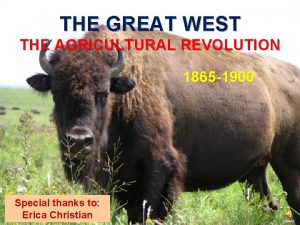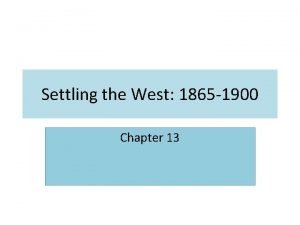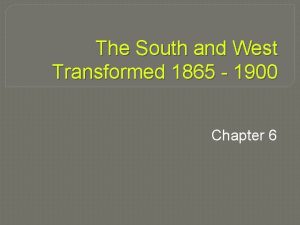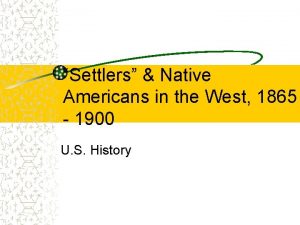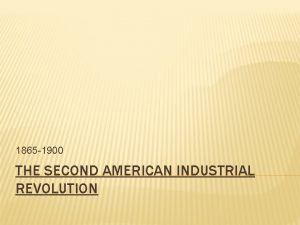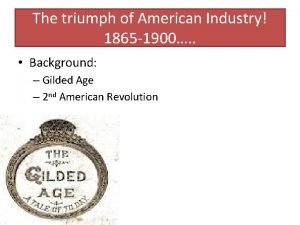The Last West 1865 1900 The Great American
















- Slides: 16

The Last West 1865 -1900

The Great American Desert, Before and After Great American Desert had few trees, little rainfall, blizzards, hot summers. 15 million buffalo provided food, clothing, shelter to Native Americans. By 1900: buffalo herds were wiped out; open lands were fenced in by homesteads & ranches; railroads & new towns crisscrossed & dotted the west. Native Americans were wiped out Four groups settled the last frontier: miners, ranchers & cattlemen, farmers

(gold, silver, ore) • In 1849 gold was found in California, leading to a gold rush. • Young men from Mexico, Europe, & China rushed to get rich. They were called “Prospectors; ” 1/3 were Chinese immigrants. • At first, they looked for placer gold (in streams). • Many hoped to find a thick vein of gold in solid rock, called a lode, like the Comstock Lode in Nevada. • This “mother lode” was worth $340 million; by 1890 • California’s Population had jumped by 400% in 10 yrs. • Miners lived in tents; boom towns popped up (merchants followed miners) • When metal disappeared the boom towns became ghost towns (everyone left). • For 30 years, prospectors looked for gold in the West. Conditions were dangerous conditions; few got rich. • Individual mining evolved into large mining companies that used machinery to wash away entire mountainsides in search of gold, which damaged the environment irreparably. Racism existed: • Miner’s Tax $20/month on foreigners • Chinese Exclusion Act 1882: prohibited Chinese immigration to US Miners

Ranchers and Cowboys (grass+ cattle were free) • Mexican vaqueros were the first ranchers (early Spanish settlers). • Ranchers fought in Civil War and didn’t return. Cattle multiplied (5 million roamed open plain) • Texans rounded them up to herd north to market. –Big profits could be made by bringing cattle to “cow towns”; from there, cows would take the train to meat packing cities • The Chisholm Trail was the most famous cattle drive trail from San Antonio to Abilene, Kansas. • 12 cowboys herded 1, 000 cattle at a time and earned $1/day. • ¼ of the cowboys were Mexican American & African American. Long drives ended when: 1. overgrazing killed grass. 2. Railroads extended southwest 1880 s – Transported cattle; brought farmers – Farmers closed open range (barbed wire fences) 3. Blizzards of 1886 -7 killed 90% of cattle bankruptcy; 4. Ranching (more stable) developed.

Settlers and Homesteaders These factors encouraged people to settle the Great Plains: 1. Railroads & land 2. Indian attacks reduced 3. Homestead Act: [though best lands were given to railroads] • The Homestead Act provided 160 acres of land to settlers who’d farm on it for 5 years. – 600, 000 farmers claimed 8 million acres. (2, 500, 000 purchased western land) • The Morrill Land Grant Act gave land to fund agriculture colleges so that crops would thrive; • Settlers faced Challenges: 1. building houses (no trees: they used holes in hills and sod) 2. Winter: deep cold, winds, blizzards. 2/3 of farms failed because of a drought in the 1890’s, grasshoppers also destroyed crops. Some left; others used dry farming techniques Technology helped: steel plow cut thick sod to plant, mechanical reaper cut and bound grain for harvest, windmills pumped water from deep wells for houses and irrigation. Frederick Jackson Turner (historian): “The Significance of the Frontier in American History”: The close of the frontier (all land settled) is the end of an era of American Democracy. US had transformed a savage land into a modern civilization. The frontier renewed American ideals of democracy & individualism; shaped the nation as a whole. Turner failed to see that whites had displaced already established societies & cultures.

• • • Railroad expansion made land available to buyers In the 1870’s, farmers poured onto the plains; turned Indian hunting & cattle’s open range into agriculture. temporary agriculture boom. [Problems: enclose land, protect it from cattle barbed wire; irrigation was necessary drilled wells or channeled water from elsewhere; 1887: DROUGHT. (required deep wells/windmills; dry-land farming; drought-resistant-crops; such irrigation the government couldn’t afford)] BUST. Overproduction lower prices; production= more expensive; FARMERS couldn’t PAY DEBTS, ABANDON FARMS After this, COMMERCIAL FARMING dominated , growing cash crops. Dependent on bankers, interest rates, railroads & shipping rates, world supply & demand. 1865 -1900 Farming became an international business. Output increased all over the world. Modern forms of communication (telephone, telegraph, railroads) created new markets. Farmers hoped the world market would absorb American surplus of goods. – 1880’s: worldwide overproduction drop in prices. – Commercial farming made some wealthy; others suffered. Farmers Experience Boom, then Bust: Growth of Commercial Farming

Farmers concentrate anger on freight rates, interest rates, currency. RAILROADS: charged higher rates to ship farm goods; controlled warehouses & charged high storage rates. INTEREST RATES: banks, loan companies charged high interest rates (10 -25%). Had to pay these when prices were dropping & currency was scarce (“Increase amount of currency!”) PRICES: had no idea what prices were going to be when they planted. Felt speculators were trying to fix prices to benefit themselves. Felt manufacturers in the East were trying to keep farm good prices low & manufactured good prices high. Indebtedness, isolation, lack of education & medical facilities (+growing urban culture) discontent of farmers Reflected in literature that idolized miners & cowboys, but not farmers. No longer the backbone of American Society. Farmers’ Anger

The New South 1865 -1900

Redeemer Governments Some places: the Old Planter Élite still ruled. Others: New ruling class: Merchants, industrialists, railroad developers, financiers =former planters, carpetbaggers, lower-class whites Goals: “home rule, ” social conservatism, economic development Policies: lower taxes, reduced spending, diminished state service (public schools), pay off war debts Readjusters (VA): dissenting group that challenged the Bourbons [revise debt payment to make more $$ for state services]. Won Senate seat & governorship. Other movements; conservative southerners had destroyed most dissenting groups by mid-1880’s.

The Agrarian South Agriculture = impoverished state Tenant farming & debt peonage in most of the region. Owners were absent; paid little attention to land. Reconstruction: 30%+ of farmers were tenants 1900: 70% of farmers were tenants Crop-lien system Farmers borrowed money against future crops; fell into debt. Forms of Tenantry: 1. Owned tools, equipment, animals; paid cash rent for land. 2. No $$ or equipment; landlord supply land, house, tools, seed, mule; farmers pay a share of crop. [rarely had anything left] = SHARECROPPING Southern Backcountry (mostly subsistence farming) Farmers grew cash crops instead of food crops to make enough $$ to pay off their loans. --livestock could no longer roam freely (“fence laws”) =end of the open range in the South =difficult for families to live selfsufficiently. Difficult for families to profit in the market ( Populist Movement).

Industrialization in the South Industrialization: Pride in new, nostalgia for old Some believed the South had lost the war because of a weak economy. Goal: create a “New South: ” (Out-Yankee the Yankees) New Values: thrift industry progress Literature shows social nostalgia [one foot in the past]: Spoke of the “Lost Cause. ” Showed slave society as racially harmonious world Popularity of minstrel shows: jokes, dances, ballads Black face blacks shown as ignorant _________________________ Growth of Textile Industry x 9 (1880 -1900) (cheap labor, water power, low taxes, conser. Gov’ts) Tobacco Processing Industry James B. Duke (NC): American Tobacco Company Monopoly on tobacco processing Iron & Steel industries Lower south: Birmingham, AL 1/5 of nation’s iron & steel capacity. Railroad Development 1880 -1890: tracks in South x 2 1886: changed track width to match North Limits: Southern share of National Industry x 2 (1880 -1900) Only 10% of the total. Same % as in 1860. Only regained wartime losses. 21% increase in per capita income. 40% of the pci of North 60% in 1860 (slaves not factored in) Much of Southern development $$ came from North “colonial economy? ” New Industrial Workforce Many factory workers = women Widows; war casualties Some entire families hired (failed farmers) Long hours; ½ pay in North African Americans No jobs in textile industry Mixed with whites in tobacco, iron, lumber mill towns determined white supremacists to act. Convict-Lease System Gangs of convicted criminals leased as free labor. Brutal treatment Denied jobs to free workers

Jim Crow Laws Rule the South • Civil Rights cases of 1883: (14 th Amendment) Supreme Court: • State gov’ts can’t discriminate based on race; private organizations can (hotels, theaters, workplaces) • Plessy v Ferguson: separate but equal accommodations did not deprive blacks of their Civil Rights. • Cumming v County Board of Education: laws establishing separate schools for whites were valid. • Disenfranchisement: poll taxes, literacy tests, grandf. Clause • Lynchings escalated (accused of crime; violated role) 187/yr • Seen as legitimate law enforcement, control, fear of sexuality • Anti-Lynching movement (Ida B Wells —black journalist)

Middle-Class African Americans • • • Former slaves acquired property, established small businesses, entered professions. Banks, doctors, lawyers, nurses, teachers “Education = vital to the future of their race” Expanded the network of black colleges Booker T. Washington = spokesman. Pres. Of Tuskegee Institute Born in slavery, worked his way out of poverty w/ an education. [school, skills, refined speech, dress, cleanliness] “by adopting the habits of the white middle class, blacks can earn the respect of whites and make social gains. ” --stop agitating for civil rights; self-improve for equality. --“Atlanta Compromise” (speech) do not challenge the system of segregation; instead focus on preparing to exercise the privileges of citizenship.

Removal of the American Indians Dozens of native American tribes occupied land in the West in 1865. Pueblos lived in permanent settlements & raised corn & livestock. Navajo & Apaches: produced arts & crafts, raised crops & livestock. Great Plains groups (Sioux, Blackfoot, Cheyenne, Crow, Comanche): gave up farming when the Spanish brought horses. Way of life centered around hunting buffalo. Lived in huge tribes, but smaller bands of 300 -500. Jackson: moved Indian tribes west. Miners, ranchers, cattlemen Westward expansion 1851: Federal gov’t moves tribes onto Reservation Land. (Plains tribes continue to follow the buffalo) move west, settle on Native Lands warfare between US troops & Plains Indians. ● 1864: Sand Creek Massacre: Colorado militia kill women, children & men ● 1866: Sioux War: US captain & men wiped out by Sioux. NEW TREATIES promised gov’t would stay away if they stayed on smaller parcels of land on the plains. Miners violate treaty. (gold found in Black Hills). Some chiefs & young warriors seek return of ancestral lands. ● 1876: Red River War: Sitting Bull & Crazy Horse Led 2 nd Sioux War. : Destroyed Custer’s men (Custer’s Last Stand) at the Battle of Little Bighorn before being defeated. ● 1877: Chief Joseph tries to lead a group of Nez Percé into Canada to escape the US gov’t ends in defeat and surrender. ● 1880’s: gov’t slaughters remaining buffalo to destroy the Indians’ way of life.

Treatment of Native Americans • • Assimiliationists: (Helen Hunt Jackson, A Century of Dishonor) decried the treatment of the Indians, but most were missionaries who wanted the Indians to become formally educated and convert to Christianity, teach them white culture & ways. Dawes Act of 1887: break up tribal organization (kept them from becoming “civilized”). Divided tribal lands into plots of 160 acres or less. US citizenship would be granted to those who stayed on the land 25 years and “adopted the habits of civilized life. ” – – • • 47 million acres distributed; 90 million acres of reservation land sold to white settlers. By 1900, disease + poverty. Reduced population to 200, 000. Ghost Dance Movement: religious movement to resist US domination. Gov’t suppressed the movement: Sitting Bull (Sioux medicine man) was killed during his arrest. 200 NA men, women, children gunned down in massacre of Wounded Knee, SD. end of the wars. 1924: Gov’t grants citizenship to Native Americans. Franklin Roosevelt’s New Deal (1930’s): Indian Reorganization Act, promoted reestablishment of tribal organization and culture. Today, 1. 8 million NA live on and off reservations. 116 tribes, 1, 000+ members.

Farmers Fight Back Populists Farmers had problems: debt to banks (machinery) debts to merchants (seeds) debt to railroads (shipping rates ) Crop prices ↓ (supply greater than demand) National Grange (social farmers’ organization) Established cooperatives (eliminate middle man); lobbied laws regulating railroad storage charges. Wabash v. Illinois (1886) (states could not regulate interstate commerce; nullified Grange gains. Interstate Commerce Ace (1886): required railroad rates to be reasonable and just. Set up a commission to investigate discriminatory practices. (helped the railroads more than farmers) POPULISM: favors commoners’ interests over wealthy people/business interests. Greenback Party increase the amount of $ in circulation (gold standard: every $ in circulation was backed by $ worth of gold in US treasury); Greenbacks failed. Farmers’ Alliances formed [education in scientific methods; economic organization]; National Alliance Ocala Convention created a platform: 1. lower tariff rates 2. graduated income tax 3. banking system regulated by federal gov’t 4. increase $$ in circulation. 5. federal storage for farmers’ crops; federal loans (no dependence on creditors) politicians who said they’d support them in 1890 election didn’t do much; formed Populist Party (People’s Party).
 The rise of industrial america 1865-1900
The rise of industrial america 1865-1900 Four features of industrial manufacturing (1865-1900)
Four features of industrial manufacturing (1865-1900) 1865 to 1900 inventions
1865 to 1900 inventions Chapter 2 settling the west
Chapter 2 settling the west Regionalism literary movement
Regionalism literary movement Benjamin west contributed a great deal to american art:
Benjamin west contributed a great deal to american art: Urban america 1865 to 1896
Urban america 1865 to 1896 St helen’s smelting co v tipping (1865)
St helen’s smelting co v tipping (1865) 1954-1865
1954-1865 Industrialization 1865 to 1901
Industrialization 1865 to 1901 Becoming a world power 1865-1917
Becoming a world power 1865-1917 Impressionism characteristics
Impressionism characteristics Chapter 20 becoming a world power notes
Chapter 20 becoming a world power notes Al cruzar una planta de guisantes de flores purpura
Al cruzar una planta de guisantes de flores purpura Where does the term impressionism come from
Where does the term impressionism come from 1877-1865
1877-1865 Industrialization (1865 to 1901 worksheet answers key)
Industrialization (1865 to 1901 worksheet answers key)

